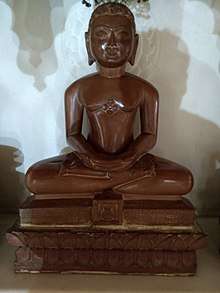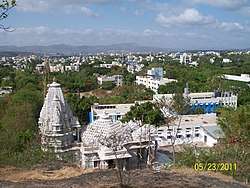Māllīnātha
| Māllīnātha | |
|---|---|
| 19th Jain Tirthankara | |
 Mallinatha statue at Anwa, Rajasthan | |
| Venerated in | Jainism |
| Predecessor | Aranatha |
| Successor | Munisuvrata |
| Symbol | Urn or Kalasa[1] |
| Height | 25 dhanusha (75 meters) |
| Age | 56,000 years |
| Color | Blue |
| Personal information | |
| Born | Ayodhya |
| Died | Shikharji |
| Parents |
|
| Part of a series on |
| Jainism |
|---|
 |
|
Jain prayers |
|
Ethics |
|
Major sects |
|
Festivals |
|
|
Māllīnātha (Prakrit Mālliṇātha, "Lord of jasmine or seat") was the 19th tīrthaṅkara "ford-maker" of the present avasarpiṇī age in Jainism. Jain texts indicate Mālliṇāha was born at Mithila into the Ikshvaku dynasty to King Kumbha and Queen Prajâvatî. Tīrthaṅkara Māllīnātha lived for over 56,000 years, out of which 54,800 years less six days, was with omniscience (Kevala Jnana).
Mallinatha is believed to be a woman named Malli bai by swetambar Jains while Digambara sect believes all 24 tirthankara to be man including Māllīnātha. Digambara tradition, believes a women can reach to the 16th heaven and can attain liberation only being reborn as a man. Digambara tradition says Mallinatha was a son born in a royal family, and worships Mallinatha as a male.[2][3] However, the Svetambara tradition of Jainism states that Māllīnātha was female with a name Malli bai.[4]
Biography
Māllīnātha (Prakrit Mālliṇāha, "Lord Jasmine") was the 19th tīrthaṅkara "ford-maker" of the present avasarpiṇī age in Jainism.[5] Jain scriptures indicate Mālliṇāha was born at Mithila into the Ikshvaku dynasty to King Kumbha and Queen Prajâvatî.[6][5] Tīrthaṅkara Māllīnātha lived for over 56,000 years, out of which 54,800 years less six days, was with omniscience (Kevala Jnana).[7]
According to Jain beliefs, Mālliṇāha became a siddha, a liberated soul which has destroyed all of its karma.[8]
Literature
- Jnatrdharmakathah gives the story of Lord Mallinath is said to be composed by Ganadhara Sudharmaswami.
- Mallinathapurana was written by Nagachandra in 1105 CE.
Main temples
- Mannargudi Mallinatha Swamy Jain Temple is a Jain temple in Mannargudi, an ancient town in the erstwhile Chola Empire of Tamil Nadu. There are plenty of archaeological evidences dating back to 250 BC.
- Chaturmukha Basadi is a famous Jain temple located at Karkala in the Indian state of Karnataka. The temple is dedicated to Tirthankar Aranatha, Mallinath and Munisuvratnath.[9]
 Chaturmukha Basadi
Chaturmukha Basadi Mannargudi Mallinatha Swamy Temple
Mannargudi Mallinatha Swamy Temple Mallinath Temple, Kosbad
Mallinath Temple, Kosbad
See also
| Wikimedia Commons has media related to Mallinatha. |
Citations
- ↑ Tandon 2002, p. 45.
- ↑ Dundas 2002, p. 56.
- ↑ Umakant P. Shah 1987, pp. 159-160.
- ↑ Vallely 2002, p. 15.
- 1 2 Tukol 1980, p. 31.
- ↑ Vijay K. Jain 2015, p. 202.
- ↑ Vijay K. Jain 2015, p. 203.
- ↑ Jaini 1998, p. 40n.
- ↑ Sandhya, C D’Souza (19 November 2010), Chaturmukha Basadi: Four doors to divinity Last updated, Deccan Herald
Sources
- Johnson, Helen M. (1931), Mallināthacaritra (Book 6.6 of the Trishashti Shalaka Purusha Caritra), Baroda Oriental Institute
- Dundas, Paul (2002) [1992], The Jains (Second ed.), London and New York: Routledge, ISBN 0-415-26605-X
- Jain, Vijay K. (2015), Acarya Samantabhadra's Svayambhustotra: Adoration of The Twenty-four Tirthankara, Vikalp Printers, ISBN 978-81-903639-7-6, archived from the original on 16 September 2015,

- Jaini, Padmanabh S. (1998) [1979], The Jaina Path of Purification, Delhi: Motilal Banarsidass, ISBN 81-208-1578-5
- Shah, Umakant Premanand (1987), Jaina-rūpa-maṇḍana: Jaina iconography, Abhinav Publications, ISBN 81-7017-208-X
- Tukol, T. K. (1980), Compendium of Jainism, Dharwad: University of Karnataka
- Vallely, Anne (2002), Guardians of the Transcendent: An Ethnology of a Jain Ascetic Community, University of Toronto Press, ISBN 978-0-8020-8415-6
- Tandon, Om Prakash (2002) [1968], Jaina Shrines in India (1 ed.), New Delhi: Publications Division, Ministry of Information and Broadcasting, Government of India, ISBN 81-230-1013-3